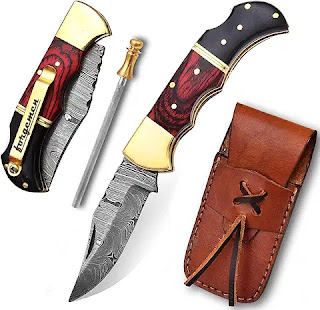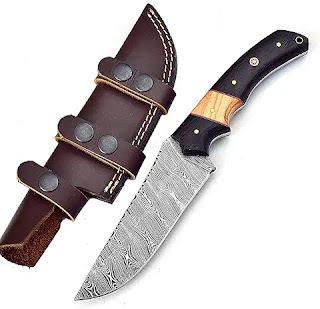Damascus Hunting Knife with Sheath: A Hunter’s Best Friend
When you step into the wilderness, every tool you carry matters. A Damascus hunting knife with a sheath is not just a tool—it’s a companion. Strong, sharp, beautiful, and dependable, it has earned the respect of hunters, outdoorsmen, collectors, and knife lovers around the world.
Let’s take a closer look at what makes this knife so special, and why every hunter or survivalist should consider adding one to their gear.
What Is a Damascus Hunting Knife?
A Damascus hunting knife is crafted from Damascus steel, renowned for its distinctive wavy patterns on the blade. This steel is not just about looks—it’s known for its sharpness, edge retention, and durability.
The hunting knife is designed for field dressing, skinning, cutting rope, or even camp chores. The blade is tough enough for the outdoors, and the artistic patterns make each knife one of a kind.
Why Damascus Steel Is Special
Damascus steel has a rich history. It was first used centuries ago in the Middle East, where blacksmiths learned to fold and forge layers of steel to make a blade that was both strong and flexible.
Key Features:
-
Sharp edge that stays longer
-
Tough and durable
-
Flexible, less likely to break
-
Unique blade pattern that looks beautiful
Each Damascus blade is handmade, so no two knives look the same. That means your knife is not just a tool—it’s also a piece of art.
Types of Damascus Hunting Knives
There are many shapes and sizes. Some are big, some are compact. Let’s go over the most popular types:
1. Fixed Blade Knife
This type has a solid, non-folding blade. It’s strong and perfect for heavy tasks like skinning a deer or cutting wood.
2. Gut Hook Knife
A gut hook is a small curve on the back of the blade used for opening up the belly of game animals without damaging internal organs.
3. Drop Point Knife
It has a thick, curved blade. Great for control and skinning.
4. Clip Point Knife
With a sharper tip, it’s good for precision cuts.
The Role of the Sheath
A knife sheath is more important than people think. It protects you and your knife.
Why You Need a Good Sheath:
-
Safety: Keeps the blade covered when not in use.
-
Portability: Allows you to carry the knife on your belt or gear.
-
Durability: Prevents the blade from rusting or dulling.
-
Style: A handcrafted leather sheath looks rugged and classic.
Most high-quality Damascus knives come with a leather sheath. Leather not only looks good but also ages beautifully, becoming softer and more personal over time.
Real-Life Story: A Hunter’s Trust
Meet John, a 38-year-old hunter from Montana. He got his Damascus hunting knife as a birthday gift from his father.
“The moment I held it,” he said, “I felt like I was holding history.”
John has taken it on every hunting trip since. From field dressing elk to slicing rope at camp, it has never failed him.
And that’s the magic—a Damascus hunting knife becomes part of your journey.
Craftsmanship: How the Knife Is Made
Each Damascus knife goes through an intense process:
-
Steel is folded over and over to create layers—sometimes over 200 layers!
-
Forging and hammering give it strength.
-
Etching brings out the patterns.
-
Blade is shaped, sharpened, and polished.
-
Handle is added, often from wood, bone, or horn.
-
Sheath is crafted, stitched, and dyed.
It’s not just a product—it’s handcrafted with love.
Materials Used in the Knife and Sheath
Blade:
-
High carbon Damascus steel
-
1084 and 15N20 steel are often combined
Handle:
-
Walnut wood
-
Camel bone
-
Rosewood
-
Micarta (for modern styles)
Sheath:
-
Full-grain cowhide leather
-
Hand-stitched
-
Sometimes dyed or tooled with traditional designs
Benefits of Owning a Damascus Hunting Knife
Let’s break it down:
| Feature | Benefit |
|---|---|
| Razor-sharp blade | Easier to skin game |
| Stylish patterns | Unique and attractive |
| High durability | Lasts for years |
| Handcrafted | Superior quality |
| Custom sheath | Safety and easy carry |
How to Take Care of Your Knife
To keep your Damascus knife looking and working great:
1. Clean After Use
Wipe it after each use. Don’t leave blood or moisture on the blade.
2. Oil the Blade
Use light oil like WD-40 or gun oil to prevent rust.
3. Keep It Dry
Never store the knife in a wet sheath. Leather can trap moisture.
4. Sharpen Carefully
Use a whetstone or fine grit sharpener. Don't use cheap electric sharpeners.
5. Store Safely
Use the sheath or a display case. Keep away from children.
Price and Value
You might ask—why are Damascus knives expensive?
Because you’re not just paying for steel. You’re paying for:
-
Craftsmanship
-
Time
-
Skill
-
Materials
-
Art
A good handmade Damascus hunting knife with a sheath can cost anywhere between $80 to $300 or more depending on:
-
Size
-
Steel quality
-
Handle material
-
Custom engraving
But it’s worth it. It’s a knife that can last a lifetime, and maybe even be passed down to your children.
Best Places to Use It
This knife is perfect for:
-
Hunting trips
-
Fishing
-
Camping
-
Bushcraft
-
Survival training
-
Outdoor cooking
And of course, many people also collect them because of their beauty and uniqueness.
Popular Brands Making Damascus Hunting Knives
Some well-known brands and makers include:
-
Moore Maker
-
Benchmade
-
Custom Pakistani Makers
-
Buck Knives
-
Cold Steel
-
Bark River Knives
But you’ll also find amazing craftsmanship from local bladesmiths—especially in places like Wazirabad, Pakistan, which is famous for making high-quality handmade Damascus blades.
Buying Tips: What to Look For
When buying a Damascus hunting knife with sheath:
✅ Check for:
-
Real Damascus pattern (not laser printed)
-
Full tang blade (blade goes through the handle)
-
Comfortable grip
-
Quality leather sheath
-
Honest seller or brand
❌ Avoid:
-
Fake Damascus (etched pattern only)
-
Weak handles
-
Loose sheaths
-
Cheap knock-offs
Always read reviews. Ask questions. A real knife maker will proudly share details about their work.
Why Collectors Love It
For collectors, a Damascus knife is like a painting. Some even collect them without using them—just for their beauty.
Some custom knives even have:
-
Engraved bolsters
-
Hand-carved handles
-
Mosaic pins
-
Rare wood like olivewood or ebony
They are often displayed in glass boxes or mounted on walls.
Conclusion: A Knife That Tells a Story
A Damascus hunting knife with sheath is more than a cutting tool. It’s a story in steel. A connection to ancient forging traditions. A helper in the woods. A showpiece at home. A gift that says, “I care.”
Whether you’re hunting deer, chopping wood, or just showing off your knife to friends, it gives you confidence and pride.
If you’re serious about the outdoors—or if you just appreciate good craftsmanship—a Damascus knife is one of the best investments you can make.
So, the next time you head into the wild, make sure you have your Damascus hunting knife by your side.










No comments:
Post a Comment